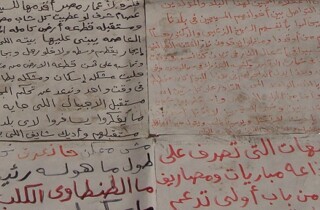In Tahrir Square
Jamie Allinson
Posters for the movie El Fagoumi, which tells the life story of the folk poet Ahmad Fuad Negm, show the actors superimposed over Tahrir Square in revolutionary tumult. The image is almost indistinguishable from the montages of the ‘Revolution of 25 January’ that play on music video channels or hang incongruously from the government offices the demonstrations were directed against.
On the streets off Tahrir, children with nowhere better to go are still sleeping rough. Men still shift huge piles of dust without shovels, or shoes. The police are different though: there are fewer of them, older professionals instead of young conscripts. Spaces where posters of Mubarak or the National Democratic Party used to hang are now dedicated to the martyrs of the revolution or to the parties and demands that have emerged since. ‘Mubarak’ underground station has been renamed ‘Martyrs’. The former president’s once ubiquitous gaze now looks down only from homemade banners demanding his speedy trial.
At the junction of Talaat Harb Street and Tahrir Square people have attached their handwritten hopes and demands to the pavement (see photo). Nobody walks on them. In the square itself, a tree is decorated with petitions. People gather there to discuss the future of the revolution. But the freedom of the square is not assured. The baltagiyya(‘thugs’) deployed by the old regime are still carrying out assaults and sexual harassment. At the northern end of the square and on many of its approaches, the paving stones are still torn up. No one seems in much of a hurry to replace them.
